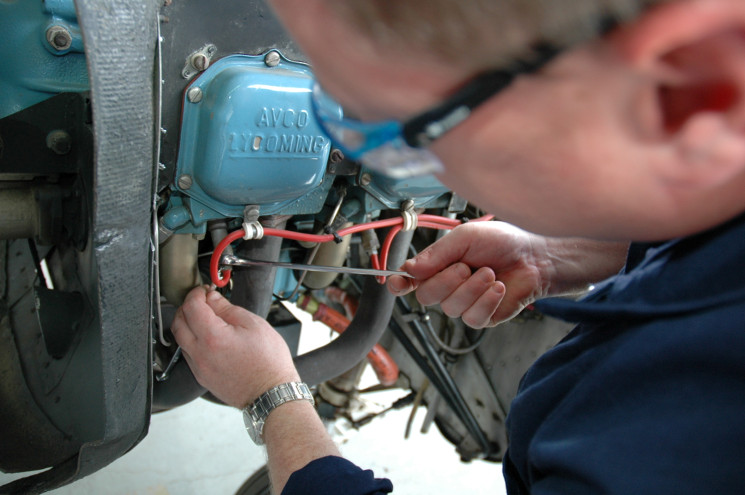1 Corrosion found mainly in extruded sections of an airframe is called:
- exfoliation
- galvanic
- intergranular
- pitting
2 When running a piston engine lean of peak, the engine will not be damaged because:
- fuel consumption is high
- a lower power is being produced
- the cylinder head temperatures are high
- RPM is high
3 VHF communication:
- requires signals to bounce off the stratosphere
- requires line-of-sight signals
- requires signals to bounce of the tropopause
- is hindered by high-altitude flight
4 FAA AC43.13-1B is considered ‘approved data’ for the purposes of:
- repairing and modifying Australian aircraft
- repairing Australian aircraft providing it is listed in the logbook entry
- repairing Australian aircraft providing it is listed in the logbook statement
- repairing non-pressurised Australian aircraft only
5 In Australia, single-engine aircraft:
- must have their weight validated every 3 years
- must be reweighed every 3 years
- do not ever require reweighing
- do not require periodic reweighing
6 In a turbo-charged piston engine at start up and low power, the wastegate is:
- closed to port exhaust gas through the impeller
- open to port exhaust gas through the impeller
- closed because the engine doesn’t require high manifold pressure
- half open because the engine doesn’t require high manifold pressure
7 In Australia, supplemental oxygen is:
- required by regulation above 10,000 feet
- required by regulation above 12,500 feet
- not required by regulation
- at the discretion of the pilot
8 At maximum cruising altitude in a turbo-normalised engine, at full throttle, the manifold pressure will:
- be higher than sea-level manifold pressure
- be sea-level manifold pressure
- be lower than sea-level manifold pressure
- vary
9 For an Australian aircraft that travels outside Australia:
- a fireproof identification plate is not required if the manufacturer’s plate is installed
- a fireproof identification plate is no longer required
- the registration is required on both sides of the aft fuselage/tail but not under the left wing
- the registration is required on both sides of the aft fuselage/tail and under the left wing
10 In a piston-engine aircraft with an engine management system during a magneto check, when the magneto switch is moved from both to right or left, the following is observed:
- RPM increases and EGT increases
- RPM decreases and EGT decreases
- RPM decreases and EGT increases
- RPM increases and EGT decreases
11 In a large aircraft hydraulic system, hydraulic fuses:
- sense a drop in pressure and close to prevent fluid loss
- detect low fluid flow and close to prevent fluid loss
- are used only in the brake system
- are used only in the primary hydraulic system
12 In a light turbo-prop engine with a constant torque, as the compressor becomes dirty:
- both the FF and the Ng will decrease
- both the ITT and the fuel flow will decrease
- both the ITT and Ng will decrease
- the ITT, FF and Ng will increase
13 In a helicopter autorotational landing, the pilot:
- glides the helicopter to a chosen landing point
- reduces collective control to maintain rotor RPM
- decreases collective pitch on the blades before touchdown
- does not use the tail rotor torque pedals at any stage
14 In a turbo-charged piston engine, why do some manufacturers recommend running the engine at low RPM after landing for 2–5 minutes before shutdown?
- to allow the oil temperature in the turbocharger to cool sufficiently and stop coking
- to allow the engine oil to cool sufficiently
- to allow the turbocharger mass to cool sufficiently
- to allow the exhaust system to cool sufficiently
15 ‘Critical mach’ speed occurs when a shockwave forms on a curved surface while in flight:
- This is the fastest speed the aircraft can fly in cruise.
- Controllability problems will occur if this speed is exceeded.
- This speed can be exceeded in cruising flight.
- The speed of the air in front of the shockwave is subsonic.
Answers:
- (c)
2. (b)
3. (b)
4. (c)
5. (d)
6. (a)
7. (a)
8. (b)
9. (d)
10. (c)
11. (a)
12. (d)
13. (b)
14. (a)
15. (c)



Comments are closed.